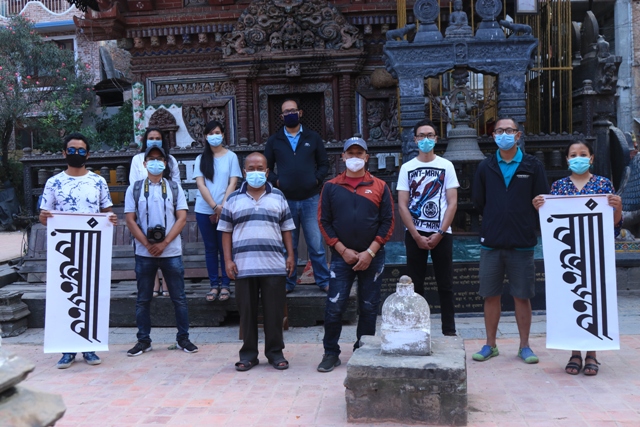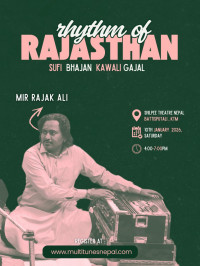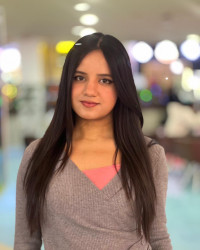Culture & Lifestyle
How this group is reviving the storytelling culture of Newa community
For the last three years, the group behind Baakhan Nyane Waa has organised 18 in-person storytelling sessions in the Valley and its adjacent Newa towns.
Ankit Khadgi
In 2017, a group of heritage conservationists and activists started a movement called ‘Campaign to Rebuild Kasthamandap’ to protest against the government’s proposed plan to rebuild Kasthamandap.
Its main demand was that Kasthamandap, which was destroyed during the devastating earthquake of 2015, be rebuilt in its original form.
To make the public realise the cultural importance of Kasthamandap and why the temple ought to be rebuilt in its original form, the campaigners, who are all from the Newa community, decided to organise public storytelling sessions related to Kasthamandap in the bahas (courtyards) of Kathmandu.
“Through stories, we wanted to document the history of Kasthamandap and let the upcoming generation, as well as other people, understand its value,” says Alina Tamrakar, a cultural activist who was involved in the campaign from the very beginning.
Tamrakar says the response to the storytelling sessions was overwhelming.
“We organised a total of four storytelling sessions and people who attended them really enjoyed it,” says Tamrakar.
Encouraged by the response, the campaigners decided to start Baakhan Nyane Waa (come and listen to stories), an initiative that focuses on reviving Newa community’s storytelling tradition.
“It was customary in every Newa household for ajus (grandfathers) and ajis (grandmothers) to tell various cultural stories to their grandchildren. For years, this oral storytelling tradition allowed the transfer of cultural and traditional knowledge from one generation to another. However, because of modernisation, the storytelling tradition is no longer as common as it was,” says Tamrakar, one of the core members of the group behind Baakhan Nyane Waa. “We started this initiative to revive the community’s storytelling tradition and engage the younger generation with the stories and make them understand the significance of our traditions.”
Before the pandemic gripped the country, Baakhan Nyane Waa organised a storytelling session every month in the bahas of Kathmandu Valley and Panauti.
For every storytelling session, the group’s members discussed and finalised a theme, storyteller, and venue.
“From the name of a place to festivals, traditions, and rituals, there’s a story behind everything in Newa culture,” says Tamrakar. “But most people are unaware or haven’t heard of these stories. Through our initiative, we wanted people to know them.”
But getting the initiative off the ground wasn’t easy.
“Since the elderlies are used to telling stories to their family members only, it was very challenging to convince them to do the same in public spaces and in front of a live audience. Many were nervous and told us that they weren’t comfortable doing it,” says Shristina Shrestha, another founding member of the group.
But once the group members explained to the elders that the vision behind the initiative is to teach the younger generation about Newa culture, many immediately came on board, say the group’s members.
“As we went around different parts of the Valley organising these storytelling sessions, we started receiving great responses from the public. People understood the significance of what we were trying to do and showed great interest,” says Tamrakar. “We even started getting invitations from locals to come to their toles (localities) to facilitate storytelling sessions.”
When the pandemic hit the country, the group had to halt their in-person storytelling sessions. Not letting the pandemic and its subsequent lockdowns hinder its activities, the group started organising virtual storytelling sessions.
“We made video recordings of stories narrated by people and broadcasted them on our Facebook account. We also started another initiative ‘Baakhan Kaane Waa’ (come and tell stories). Through the medium of social media, we conducted several sessions online where elderly people came and shared many stories. But we had to discontinue the virtual sessions because we were facing a lot of challenges conducting them, with one of them being elderlies not being able to operate the digital devices,” says Tamrakar.
In April this year, the group organised its first-ever physical storytelling session in more than a year. The venue for the session was on the premises of Nala, Bhaktapur.
But according to members, what Baakhan Nyane Waa does isn’t just a mere storytelling session. Staying true to the roots, every session of theirs is organised in a way that reflects a part of Newa culture.
“In every storytelling session, the storytellers sit in the middle and the audience sits around them. Everyone sits on suku (traditional mats),” says Shrestha. “Traditionally, baakhan paa (a basket full of popcorn and snacks) would be distributed as snacks to listeners. We do the same at our storytelling sessions and we want to evoke a sense of nostalgia among our listeners.”

Until now Baakhan Nyane Waa has organised more than eighteen live sessions on various themes, including stories on the origin of significant festivals like Gunla, Yenya (Indra Jatra), Kaati Pyaakhan (Kartik Naach), and others.
Two weeks ago, during the month of Gunla, the group also released their first-ever children book ‘Nyuk Baja ra Gunla’ based on the story narrated by Swatantra Bahadur Tamrakar, the baajan guru of Tamrakar Gunla Baajan Khala.
According to the group’s members, they prefer to organise their storytelling sessions in Nepalbhasa, as it’s the language in which most of the narrators are most comfortable speaking.
However, to make their sessions more accessible to those who don’t understand Nepalbhasa, the group records the storytelling sessions and uploads the videos on their Facebook and Youtube account along with Nepali subtitles.
In the few years since Baakhan Nyane Waa’s inception, it has managed to earn many admirers. One of their prominent admirers is cultural expert and retired professor of Nepalbhasa, Chunda Bajracharya, who has been following their initiative since the beginning.
“They [Baakhan Nyane Waa] are doing an amazing job. Reviving the tradition of storytelling, which is an integral aspect of Newa culture and civilisation, at a time when the tradition is slowly fading is a great way of preserving and promoting our knowledge and values,” says Bajracharya.
From the Rana regime to the Panchayat, multiple governments made efforts to control the development of the indigenous language. The country’s autocratic regimes arrested and even murdered people who wrote in languages other than Khas Nepali.
Given the hostility towards indigenous languages, many communities relied on oral history to pass knowledge on cultures and traditions to future generations. And that’s why Bajaracharya believes that initiatives like Baakhan Nyane Waa should be promoted and replicated especially among indigenous groups who unfortunately don’t have rich written history and documentation like the privileged groups.
“Initiatives like Baakhan Nyane Waa can make people realise that the preservation of oral history is equally important,” says Bajracharya.
After years of organising storytelling sessions and publishing a book, the group behind Baakhan Nyane Waa is now working on producing animation and cartoon videos to further their goals of preserving the age-old Newa community’s storytelling tradition.
But at the core, Baakhan Nyane Waa, say members of the group, will always be oral storytelling.
“Stories are our intangible heritage. Every story has a hidden message and logic behind it, and it’s through the stories that we get to know about our past,” says Tamrakar. “Hence at Baakhan Nyane Waa, we will always give priority to promoting the storytelling tradition that is deeply rooted in our culture.”




 8.12°C Kathmandu
8.12°C Kathmandu













%20(1).jpg&w=300&height=200)

